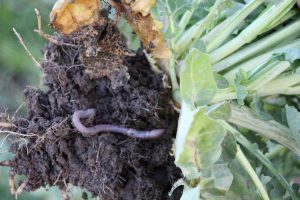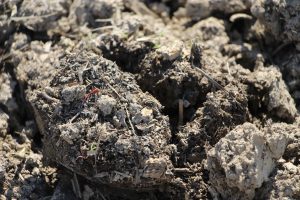Conservation, Homepage Slider, Water Quality
Improving Water Infiltration and Permeability
By James Hoorman, Hoorman Soil Health Services
Our summer rains have been quite variable. Some rains have been hard and fast while others have been slow and steady. About 10 days ago, “million-dollar” rain occurred; a slow steady all day 1” total rain. Million-dollar rains are called that because farmers assume that 100% of that precipitation can be utilized to increase crop yields. Yet, after that rain, a drive through the country side showed water standing in many fields. Dry weather occurred before this rain and the subsoil was dry. So why did these fields have standing water? The answer lies in poor soil structure due to excess tillage, a lack of active carbon, reduced soil microbial life (beneficial mycorrhizal fungi), and a lack of live roots year-round. These factors lead to dense hard crusted soil that seals over easily. Soils that seal over tend to have standing water and high potential for water and nutrient runoff.
Typical permeability for a Hoytville soil is .6 to 2.0 inches of water per hour while a Latty or Fulton soil has .2 to .6 inches water per hour in the top 0-7 inches. Our soils should have the capability to absorb a slow steady all day 1-inch rain. A 1957 soil survey stated that Hoytville soil do not tend to have water runoff. However, when soils are excessively tilled, the added soil oxygen causes soil bacteria to thrive and consume the active carbon that gives our soils good soil tilth. Tilled soil has more very fine soil particles called microaggregates that tend to set up like cement when the soil surface gets wet. This prevents water from infiltrating the soil, so it tends to pond, causing soluble nutrient laden water to runoff.
Healthy soils contain more active carbon that comes from root exudates and microbial by-products. These glues and sugars in the soil are food for microbial life but also improve soil structure to allow air, water, and gases to permeate into the soil. Active carbon binds the microaggregates into larger macroaggregates.  When soil is hard and dense and seals over it is composed of mostly microaggregates. When a healthy soil crumbles easily, has a good smell, and has adequate carbon (both active and long-term humus), the soil generally has more macroaggregates and better soil structure. Good soil structure reduces soil sealing and allows water to infiltrate and percolate through our soils.
When soil is hard and dense and seals over it is composed of mostly microaggregates. When a healthy soil crumbles easily, has a good smell, and has adequate carbon (both active and long-term humus), the soil generally has more macroaggregates and better soil structure. Good soil structure reduces soil sealing and allows water to infiltrate and percolate through our soils.
Healthy soils have a variety of beneficial fungi microbes. About 288 mycorrhizal fungi species are known to be beneficial to our crops. These fungi are like root extenders, bring back water and plant available nutrients to the plant. There can be several miles of these mycorrhizal hyphae just in a handful of soil. When they die or break apart, their cellular contents (glomalin) spills into the soil, coating soil particles with this sugar protein. Glomalin glues our small soil particles together to promote good soil structure.
Fungi need live roots year-round to thrive and the macroaggregates they form is a storehouse for carbon and essential plant available nutrients. An added benefit to improving soil carbon is water holding capacity. Our soils typically hold .5 to 1.0-acre inch of water for every 1% soil organic matter. With 4% soil organic matter, a typical soil could hold 2-4 inches of water per foot of soil. Increasing soil carbon improves water holding capacity.
After a 1” million-dollar rain occurs, if a farmer sees standing water, take a shovel and investigate. If you dig down 1-2”, chances are you will find dry soil and a soil surface that is sealed over. Sealing occurs because the soil particles cement together due to a lack of active carbon. Soils with poor structure have a negative charge and positive ions like potassium and magnesium seal your soil. Active carbon and calcium allow soil particles to clump together for better water infiltration and percolation. Vertical tillage, a lack of active carbon and glomalin from healthy microbes, and a lack of year-round roots cause to this problem.
Since wheat harvest has occurred with a long summer growing season remaining, now is a good time to plan ways to improve soil structure. Cover crops like sorghum, sudan, sorghum sudan, oats, cereal rye, radish, buckwheat, sunflower and many types of legumes and clovers can be planted to provide active living roots. Live roots increase active carbon and beneficial microbes needed to improve soil structure. Improving soil health with good soil management increases farm profits while benefiting the environment.